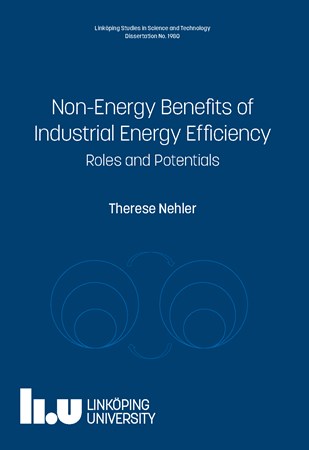Several secondary effects
In her doctoral thesis Non-Energy Benefits of Industrial Energy Efficiency – Roles and Potentials, Therese Nehler investigates the added values that can arise, and the extent to which these are included in the support information when deciding on various energy efficiency measures. Nehler has principally used interviews and questionnaires to study several large, mainly Swedish, industrial companies.
Positive secondary effects may be such factors as a better work environment, increased productivity, less waste, and longer lifetimes for machinery. Certain added values can in turn give rise to other positive effects: new low-energy lamps, for example, can give better illumination (and thus a better work environment), which may lead to fewer faults and higher productivity.
Therese Nehler has studied energy efficiency measures in large pressurised-air systems.
“One common measure is to seal against leaks in the lines that carry the pressurised air. This saves energy, and it also reduces the hissing from leaks. This improves the work environment and reduces the load on the compressor. It increases lifetime and reduces the need for maintenance.”
Therese Nehler.
“These effects do not arise as a chain, but more or less immediately after a measure for improving energy efficiency is introduced. They may also arise as delayed chained effects, where one added value leads to another. I must admit that I was surprised by the large number of positive added values”, says Therese Nehler.
Used in certain cases
Previous investigations have shown that the value of secondary effects may be as large as, or even larger than, the value of the energy efficiency measures themselves. It is in general difficult to calculate the magnitude of the added value, and to convert it into financial terms, which is a problem both for companies and researchers. Further, it is often difficult to know what is cause and what is effect when productivity increases, or the work environment is improved. Changes may have several causes.
Such difficulties mean that positive added values are relatively seldom included when making decisions about energy efficiency. They may, however, be used in certain cases as an extra argument, and may in exceptional cases be included as part of the justification for the complete investment.
“The larger the investment being considered, the more likely it is that added values are included. This may be because the risk increases, which means that more, and diverse, justifications are needed.”
Therese Nehler believes that it is important that companies take secondary effects into consideration.
Further reason to action
“Indeed – they may play a major role. We know that many energy-conservation measures are never carried out. If the added value is added to the discussion, it is a further reason to take a decision and do something.”
Are there examples of the opposite – negative secondary effects?
“Well, I don’t have as much data about this, but it is quite clearly a possibility. One risk is that new technology sometimes increases the need for personnel during the implementation, and this increases the costs of operation and maintenance.”
In the thesis, Therese Nehler also demonstrates that an organisation that works with energy management can benefit from new types of added value. An industrial company that continually carries out various energy-management measures increases awareness and interest for energy issues among its employees.
